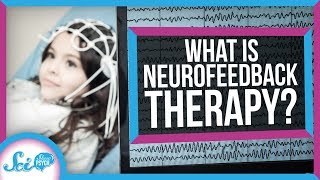(单词翻译:单击)
What if you could change your behavior just by monitoring your brainwaves?
如果仅仅通过监测脑电波就能改变你的行为,你会怎么想?
That's the goal of neurofeedback therapy, a non-drug method used to treat conditions from ADHD to depression and anxiety.
这就是神经反馈疗法的目标,这是一种用于治疗从多动症到抑郁症和焦虑症的非药物疗法。
But the science behind neurofeedback is far from solid.
但是神经反馈疗法背后的科学理论还远远不够坚实。
While it has some credible foundations, they're buried pretty deep.
虽然它有一些可靠的基础,但它们埋得相当深。
And the research in this field is riddled with conflicts and contradictions.
这一领域的研究充满了冲突和矛盾。
Including whether the brainwaves it aims to correct are all that wrong in the first place.
包括它要纠正的脑电波是否在开始就是错误的。
Neurofeedback is a type of therapy that uses real-time data – usually electrical data in the form of EEGs -- to supposedly teach you to regulate your brainwave patterns.
据说,神经反馈是一种使用实时数据指导你调节脑波模式的治疗方法,这种实时数据通常是脑电图形式的电子数据。
And the treatment relies on two concepts.
这种治疗依赖于两个概念。
The first is operant conditioning: the idea that consequences can strengthen a behavior.
第一个是操作性条件:即结果可强化行为的观点。
Which is a bedrock principle of modern psychology -- we know that rewards are great for changing behaviors.
这是现代心理学的基本原则,我们知道奖励有利于改变行为。
The second concept is neural plasticity.
第二个概念是神经可塑性。
When psychologists talk about brains being plastic, they don't mean, like, plastic plastic.
心理学家说大脑是可塑的,并不是说大脑像塑性一样啊。
They mean that the way our brain is structured, and therefore how it functions, is always changing and adapting to what life demands of us.
他们的意思是,我们的大脑结构和它的功能总在改变,不断适应我们的生活需要。
Neurofeedback leans heavily on both of these ideas.
神经反馈很大程度上依赖于这两个概念。
The reasoning is that if you reward people for the behavior or EEG pattern you want to see from them -- like concentrating better or calming down from an anxious state
理由是,如果你想通过奖励人们,让他们再次重复某种行为或出现某种脑电图模式,比如更好地集中注意力或从焦虑状态中冷静下来,
-- you'll see lasting changes to neural pathways that make them easier to achieve.
你会看到能够使这些更容易实现的神经通路的持久性变化。
During a neurofeedback session, readings of electrical brain activity are analyzed as they happen, and feedback is given to the patient on whether or not those patterns look, well, normal.
在一个神经反馈过程中,会分析大脑电活动的读数,并向患者反馈这些模式是否正常。
This is despite the fact that there's a lot of natural variation in what a "normal" brainwave is -- so neurofeedback practitioners are enforcing a subjective standard here.
“正常”的脑电波有很多自然变化,所以从事神经反馈的专业人员在这里强制实施一种主观标准。
In theory, this helps the patient pinpoint ways to keep those apparently abnormal brain waves in check.
从理论上讲,这有助于患者精确地找到控制那些明显异常的脑电波的方法。
For example, if a patient is undergoing treatment for anxiety, they can actively try to alter their brainwaves, through focusing, relaxation or whatever helps them look more "typical".
例如,如果患者正在接受焦虑治疗,他们可以通过集中注意力、放松或其它帮助他们看起来更“正常”的方法,积极尝试改变他们的脑电波。
If they manage it, they get a reward, like, showing them their favorite movie.
如果他们成功了,会得到奖励,比如给让他们看最喜欢的电影。
Using this system of feedback and rewards, practitioners say they can train people's brain activity to be in line with supposedly normal brainwaves.
通过这种反馈奖励系统,专业人员说他们可以训练人们的大脑活动,使其与正常的脑波一致。
And that is supposed to resolve symptoms of a ton of different disorders!
这应该可以解决大量不同疾病的各种症状!
ADHD, schizophrenia, depression -- and more.
多动症、精神分裂症、抑郁症等等。
Again -- in theory.
再说一遍,理论上是这样的。
Generally speaking, the research into neurofeedback is kind of a hot mess.
一般来说,对神经反馈的研究有点一团乱麻的感觉。
Some meta-analyses, which look at data from across several studies to spot trends, say it's effective, but others don't.
一些从多个研究的数据中查找趋势的元分析认为,这样做是有效的,但其他研究则未发现效果。

One review from 2016 gives a good snapshot of the situation, and suggests why analyses might come to such different conclusions.
2016年的一篇综述研究很好地反映了这种情况,并提出为什么分析可能得出如此不同的结论。
After trawling through everything, they identified 30 studies, with a grand total of 1171 participants, that met their criteria for being scientifically sound.
搜遍所有的文献之后,他们找到30项研究,共计1171名参与者,这些研究符合他们要求的科学合理性标准。
That meant participants were randomized into experimental or control groups, and that both participants and experimenters were blind to which experimental condition they were in.
这意味着参加者被随机分为实验组或对照组,参加者和实验者都对他们所处的实验条件一无所知。
They also ensured the included studies were not funded by companies that sell neurofeedback sessions, which might have led to the findings being skewed.
他们还确保所包含的研究没有得到提供神经反馈疗法的公司的资助,因为这样可能导致研究结果出现偏差。
Overall, the review of these 30 studies found mixed results.
总的来说,回顾这30项研究,发现它们的结果参差不齐。
Many of the studies showed that neurofeedback had some effect, but the researchers found serious limitations throughout the entire body of research.
许多研究表明,神经反馈疗法具有一定效果。但研究人员发现就整体研究而言,存在着严重的局限性。
The methods used in a lot of the studies weren't as rigorous as they needed to be to suggest neurofeedback had any effect.
许多研究中使用的方法,并没有按照建议应用神经反馈疗法能产生效果那样严格地实施。
Many of the studies were poorly controlled.
许多研究对元素的控制很差。
Only three of those 30 studies had a placebo group -- an important control that makes sure people don't start feeling better simply because they expect to.
这30项研究中只有3项设有安慰剂组,这是一项重要的控制措施,可以确保人们不会仅仅是因为期望而开始感觉病情好转。
And most had sample sizes that were far too small to draw any real conclusions.
大多数样本量太小,无法得出任何真实的结论。
They concluded that more large, well designed studies were needed before neurofeedback could be considered a viable treatment.
他们得出的结论是,在神经反馈疗法能被视为一种可行的疗法之前,需要进行更大规模、设计良好的研究。
While some patients seem to have found relief via neurofeedback, that doesn't necessarily mean that neurofeedback affects people in the way we think it might.
虽然有些患者接受神经反馈疗法后,病情得到缓解,但这并不意味着它会像我们认为的那样去影响人们。
Some scientists raise issue with the fact that neurofeedback practitioners might be targeting certain EEG variations that don't have much to do with the conditions they aim to treat.
一些科学家提出这样的问题,即从事神经反馈的专业人员可能针对的是某些脑电图变化,而这些变化与他们要治疗的疾病没多大关系。
After all, EEG patterns differ from person to person.
毕竟,脑电图模式因人而异。
Two people's patterns may not match each other, but that doesn't make one of them abnormal.
两个人的脑电图模式可能不相匹配,但这不会使其中一个不正常。
Critics argue that when there is a shift in a patient's condition or EEG after neurofeedback, it might just be the result of the patient being conditioned to relax or refocus their attention.
批评者认为,患者的病情或脑电图在接受神经反馈疗法后发生变化,可能仅仅是病人习惯于放松或重新集中注意力的结果。
But there's no reason to think that some supposed problem with their brainwaves has actually been fixed.
但是没有理由认为,通过脑电波假定的一些问题实际上已经解决了。
If the patient feels better about their condition, great -- but it still doesn't mean neurofeedback is doing what its backers say it's doing.
如果患者感觉病情好转,那就太好了。但这仍然不意味着神经反馈疗法会像支持者描述的那样。
Even if it helps people somehow, we need to know whether it works the way they claim.
即使它在某种程度上帮助了人们,但我们也需要知道它是否按照他们的要求工作。
For neurofeedback to really come into its own as an evidence-based therapy, its practitioners will need to address all of these concerns.
为了让神经反馈疗法真正成为一种循证疗法,它的实施者需要解决上述的所有问题。
They'll need to improve their study designs.
需要改进研究设计。
They'll need to really show what an atypical EEG looks like, and then show that training those patterns improves the conditions they're supposedly associated with.
需要展示出不典型的脑电图是什么样子,然后展示训练这些模式能够改善与这些训练相关的病情。
Until then, however, we'll need to wait for some more rigorous research.
然而,在此之前,我们需要等待一些实施更为严格的研究。
Thanks for watching this episode of SciShow Psych.
感谢收看这一集心理科学秀节目。
Some of the best feedback comes from our community of supporters.
一些最棒的反馈来自我们的支持者社区。
To learn more, head on over to patreon.com/scishow.
要了解更多信息,请访问patreon.com/scishow。


